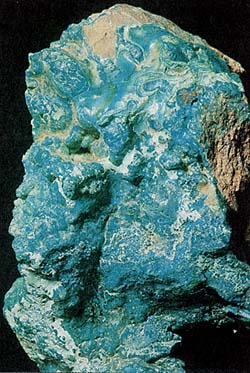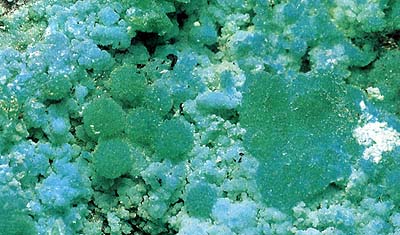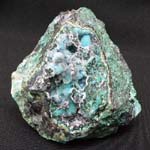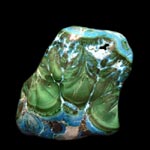Chlorites (silicates): Chrysocolla
 Diagnostic Card.
Diagnostic Card.
In the photo - concretion weight chrysocolla. Below: microcrystalline chrysocolla unit, consisting of globules (Elba Island).
Cu 2 H 2 Si 2 O 5 (OH) 4 * n H 2 O
Crystal system orthorhombic or monoclinic
Hardness 2-4
The proportion of 2-2.4
Cleavage is absent
fracture conchoidal
Bluish-green color
Color powder green-white
Shine from the glass to the wax
Chrysocolla mostly an amorphous mixture of different silicates and copper hydrated silica containing a variety of impurities, such as alumina, copper oxides and limonite. For these reasons, a typical blue-blue mineral can be darker, until the transition into brown. It occurs in the form of solid nodules, sometimes in the form of massive cryptocrystalline aggregates with thin radiant or globular structure, sometimes there are microscopic needles. Gloss units at earthy and translucent wax, until the glass due to higher silica contents.
Green or blue color in the presence of iron oxides and copper color changes to brown and black. Published data for chrysocolla in part contradictory and, therefore, it is fair to assume that the true nature of this mineral has not been established. In any case, the water content constant. Habit. In the form of crystals it does not occur, usually present in very fine fiber or bulk and, in some cases, the earthy mass.
 Crystal system, symmetry class, space group. Chrysocolla described variously as an amorphous with Si4O10-layers present in the defect structure (and referred it to the layered silicate) as Cryptocrystalline either unknown, or with orthorhombic system (in this case it refers to the carcass silicates), a monoclinic ( without referring to any group of silicates) and as a mixture of colloidal plansheita, Cu8 Si8 O22 (OH) 4 * H2O, and shatukita, Su5 (SiO3) 4 (OH).
Crystal system, symmetry class, space group. Chrysocolla described variously as an amorphous with Si4O10-layers present in the defect structure (and referred it to the layered silicate) as Cryptocrystalline either unknown, or with orthorhombic system (in this case it refers to the carcass silicates), a monoclinic ( without referring to any group of silicates) and as a mixture of colloidal plansheita, Cu8 Si8 O22 (OH) 4 * H2O, and shatukita, Su5 (SiO3) 4 (OH).
In the old days turquoise is often replaced by no less brightly colored mineral blue - chrysocolla. From a chemical point of view, this stone is an aqueous copper silicate, which gives the blue stone. The term "chrysocolla" has a very ancient origin. So I called this mineral in the IV. BC. e. Theophrastus.
Its other old name - elatsky stone - chrysocolla kopyam received by King Solomon, located near the Gulf of Eilat in the Red Sea and the same city where it was mined in the olden days in a fair amount. It should be stipulated that elatsky stone chrysocolla is not in its pure form, but only the veins of this mineral in light sandstone.
Diagnostic features.
In contrast to the turquoise, for which it is often mistaken, chrysocolla when immersed in hydrochloric acid forms on the surface of the yellow plaque. Green Chrysocolla similar to malachite, but under the influence of her HCl bubbles are not allocated.
Origin.
Mineral found mostly in the surface portion of copper ore deposits and oxidation zone formed initially as a gel comprising silica, water, and copper.
Place of Birth.
Widespread in the world, chrysocolla is found in large clusters in Chile, the United States, Zaire, the People's Republic of the Congo, the United Kingdom and Russia. In Italy, chrysocolla is found on the edges of the glacier Predarossa in Val Masino (Sondrio Province), Campiglia Marittima (Livorno Province), in the mountains Monzoni Val di Fassa (province of Trento). In our time, chrysocolla known deposits in the Urals, in Kazakhstan, the United States, Zaire, Chile.
Application.
Chrysocolla is used in jewelry; basically it is exposed to cut into a cabochon.





Distributed in Chile, the CIS (the Urals), USA (Ariz., Nevada), Zaire (Shaba). Chrysocolla can be confused with blue chalcedony, turquoise, varistsitom. Hrizokollovym quartz is sometimes called accretion chrysocolla and quartz, and Eilat stone - chrysocolla fusion with turquoise and malachite.
- Gatchell - "New Almadén snag" - arsenide and antimony sulfide (modern sulphosalts)
- Antimony - toxic metal (semi-metal) are widely used in industry, medicine and engineering
- Zirconium - a rare and non- metal and dangerous jewel in the oxide and salts
- Gold - yellow dangerous and toxic metal -date and accurate digital cable technology
- Sulphur - a golden-yellow toxic substance and a sign of volcanic activity
- Cadmium - a toxic uncirculated unknown wide range of people silvery metal
- Lead - a poisonous gray simulator silver metal and toxic metal snag
- Arsenic - poison classic medieval and modern poisoners and medicine in medicine
Toxic and hazardous radioactive rocks and minerals
** - Poisonous stones and minerals (obligatory check in chemical laboratory + clear indication of toxicity)
** - Radioactive rocks and minerals (obligatory check on a regular dosimeter + ban on the open sale of radioactivity in the event of more than 24 mR / hour + additional measures to protect the population)
Catalog minerals and gems in groups of the world
** - Poisonous stones and minerals
** - Radioactive rocks and minerals


Comments
Commenting, keep in mind that the content and the tone of your messages can hurt the feelings of real people, show respect and tolerance to his interlocutors, even if you do not share their opinion, your behavior in terms of freedom of speech and anonymity offered by the Internet, is changing not only virtual, but real world. All comments are hidden from the index, spam control.